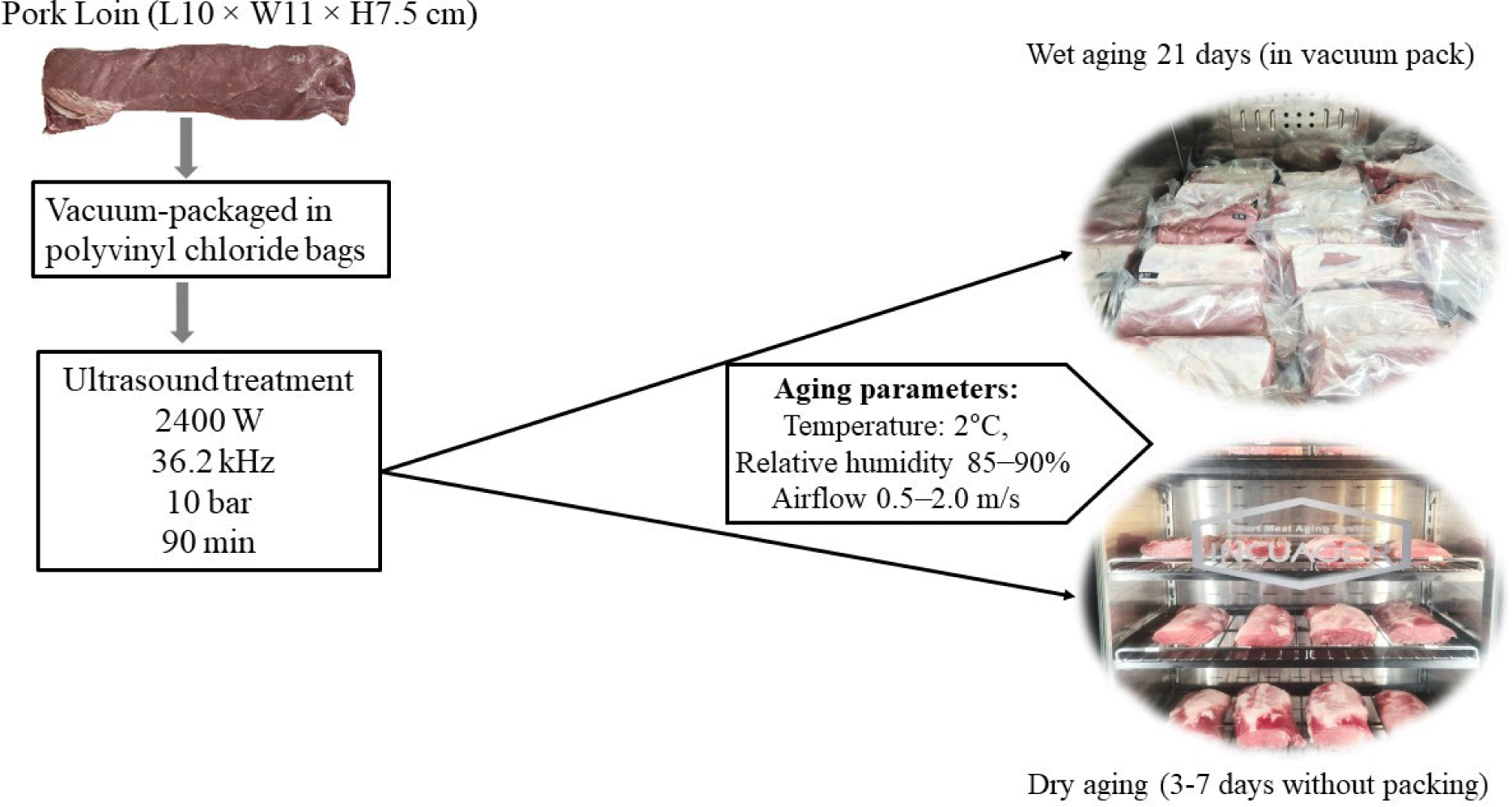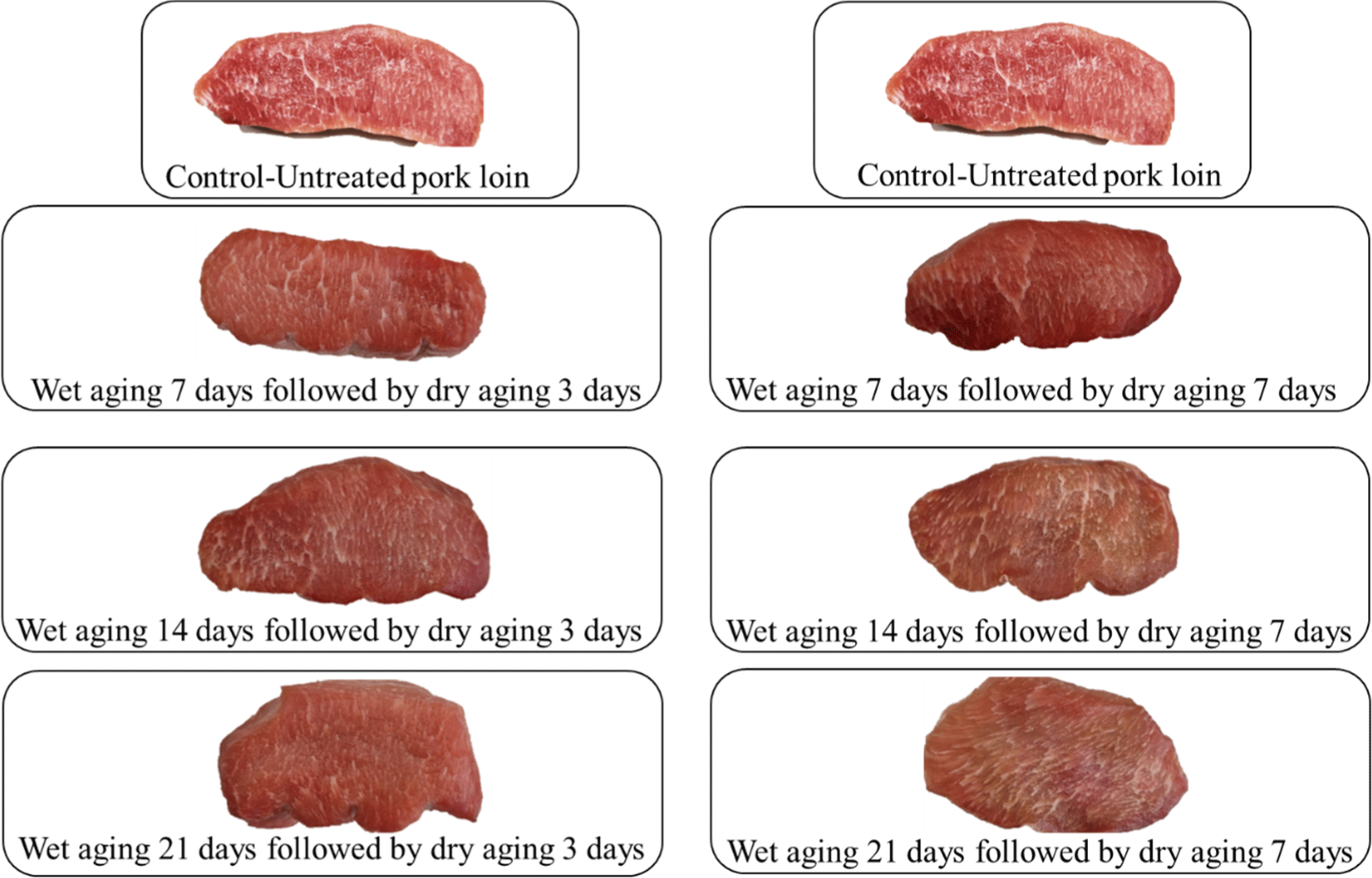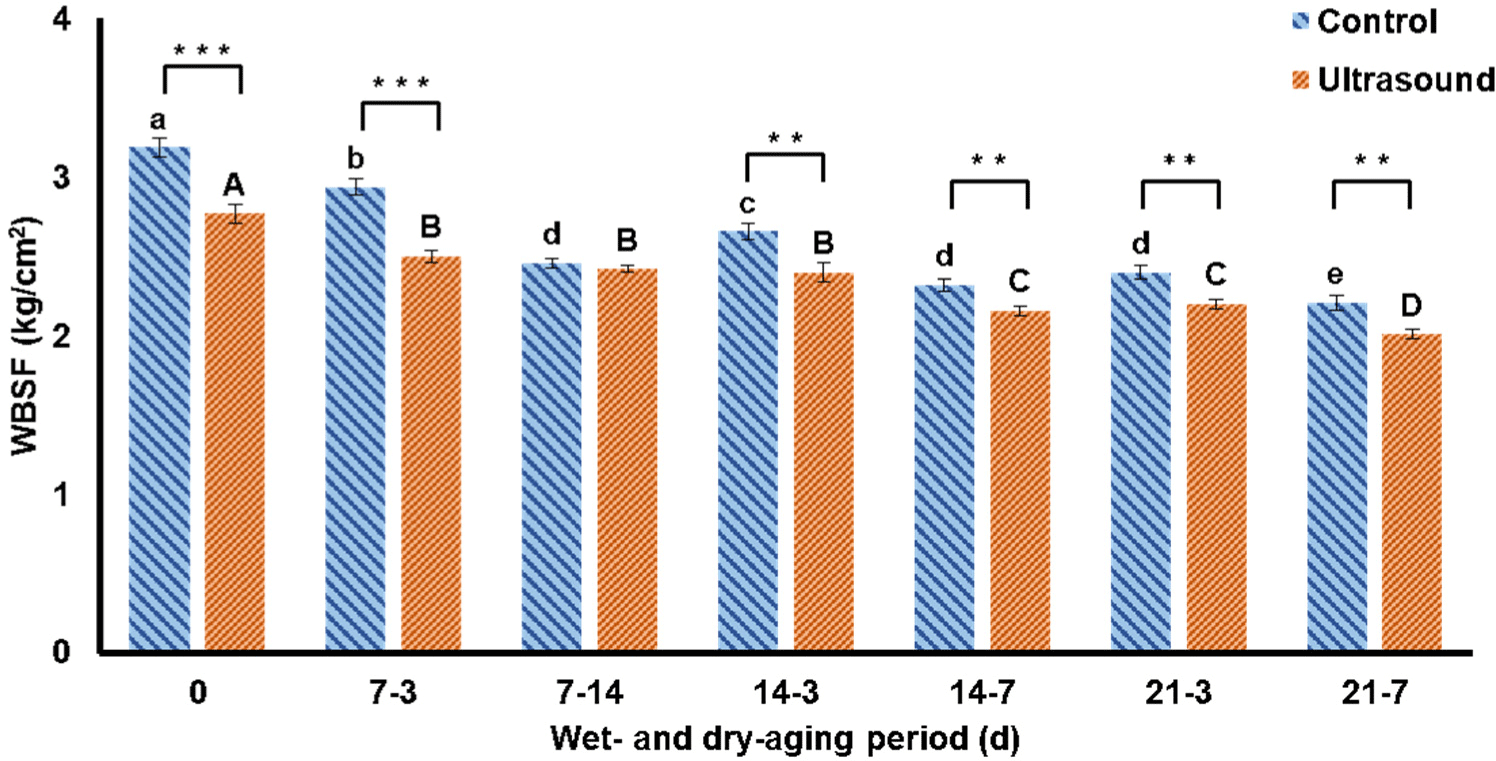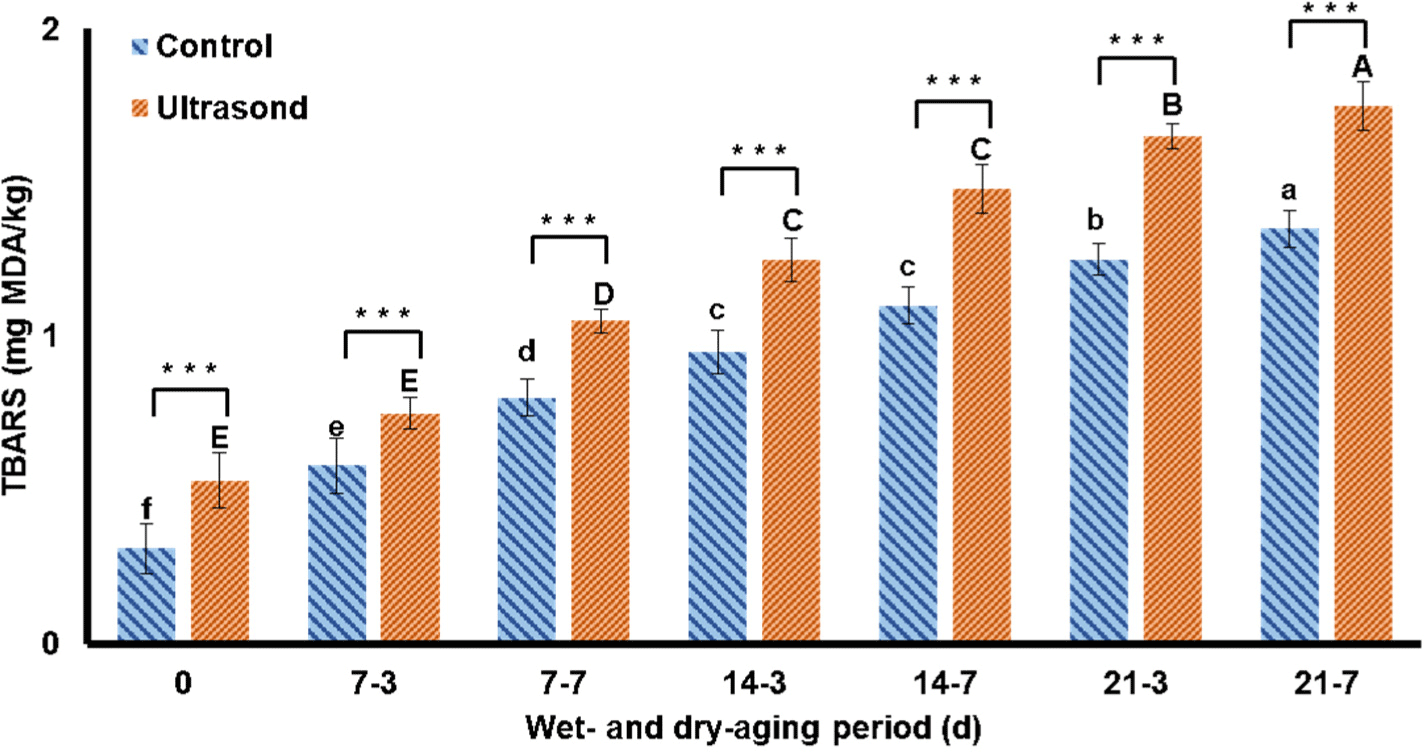Introduction
The growing worldwide population has anticipated an increase in meat production and consumption. Furthermore, rising income trends drive consumers towards high-quality meat with excellent nutritional profiles and diversified product categories. Pork meat is one of the most used meats in the world, while pork meat production is increasing day by day. In 2016, Pork production in the Republic of Korea was 891,000; by 2021, it increased to 1,097,000 tons (KOSIS, 2022). The number of pigs raised increased as there were 10,366,779 in 2016 and 11,216,566 in 2021, and pork consumption also increased during this tenure (Korea Institute for Animal Products Quality Evaluation, 2021). Consumers demand that the quantity and quality of meat should be improved (Park et al., 2022).
Meat aging is a traditional technique used for preservation. Meat aging is a prominent technique in the meat industry for processing meat products, as it enhances the longevity, taste, succulence, and tenderness of the flesh (Terjung et al., 2021). Aging plays the main role in manufacturing high-quality products (Mungure et al., 2020). Aging is largely divided into wet-aging and dry-aging. Wet aging, in other words, known as vacuum aging, is known as a reasonably inexpensive methodology where meat is vacuum packed and refrigerated (Smith et al., 2008) to stop bacterial growth and weight loss brought on by water evaporation (Campbell et al., 2001). To improve meat quality e.g., tenderness and flavor, wet aging has been widely used (Hwang and Hong, 2020). In the dry aging technique, unpacked meat is usually stored in a refrigerator with regulated humidity (62%–85%) and at a temperature of around 4°C. However, this procedure is costly due to more time and space requirements (Stenström et al., 2014). Additionally, the dried surface is responsible for weight loss during trimming (Smith et al., 2008). The recent studies have shown that although the optimal times for dry aging is 14–21 d and 7–10 d for wet aging, the dry aging of meat has been conducted up to 60 d (Leroy et al., 2004).
US has been successfully used in meat processing along with aging or curing in meat processing industry to address several issues through the novel application of mechanical, chemical, and thermal influences on the muscle structure. On the other hand, high intensity ultrasound (HIU) is a nonthermal method that became popular for producing naturally tasting processed meat products. In this method, sound energy is used lower than microwave frequencies (10 MHz) and higher than the human audible range (>20 kHz) for tenderization of meat and shelf life extension (Alarcon-Rojo et al., 2015). Both low-intensity (20–100 kHz) and high-intensity (>5 W/cm2 or 10–1,000 W/cm2) are widely employed for processing pork meat (Ashokkumar, 2011). Alternative technologies like HIU have been explored to enhance brining and lower the use of chemical additives/preservatives to maintain meat safety (Delgado-Pando et al., 2021; Singla and Sit, 2021). HIU is appealing since it can specially lower the amount of sodium and phosphates used in cured pig product processing (Zhang et al., 2021) and aids in producing meat products with clean labelling (Al-Hilphy et al., 2020; Rudy et al., 2020).
Research studies indicated that US offers notable benefits in the areas of refrigerated storage (Zheng and Sun, 2006), during meat thawing (Miles et al., 1999), salt cured meat (Cárcel et al., 2007), cooked processing (Chemat et al., 2011), improved microbiological quality (Caraveo et al., 2015), improved sous vide processing (Lee et al., 2023b), and tenderizing (Peña-González et al., 2017). The application of US in meat aging is prevalent because of its substantial effect on cavitation, which causes improved efficiency of mass transfer and reduced curing time (Li et al., 2024). The application of US from 20–100 kHz is included as a cutting edge technology and shows great potential in terms of meat tenderization, and meat functional properties, and has the advantage of accelerating the processing time (Inguglia et al., 2018). The US is divided into high intensity/low frequency (>10 W) and low intensity/high frequency (<1 W) as per the intensities of US (Li et al., 2024). US can be recognized as a nonthermal phenomenon, however, the generation of heat occurs through mechanical friction caused by mechanical vibrations during propagation, resulting in a temperature increase ranging from 1 to 10 degrees (Zhang and Abatzoglou, 2020). Recently, researchers have focused more attention on HIU rather than low intensity ultrasound. Many recent studies have reported the use of HIU on fresh meat with interesting benefits have found in freezing, thawing, marination, cooking, bacterial inhibition, and tenderizing (Caraveo et al., 2015; Cárcel et al., 2007; Chemat et al., 2011; Miles et al., 1999; Peña-González et al., 2017; Zheng and Sun, 2006). There is potential for HIU and aging in meat categories like cultured meat (Joo et al., 2022) and hybrid culture meat (Alam et al., 2024). The application of wet-dry mixed aging coupled with the application of HIU in pork has been rather scarce. Therefore, the objective of this study is to examine the alterations in meat qualities resulting from the use of wet-dry mixed aging and HIU.
Materials and Methods
Samples of loin from 6 porcine (LYD, 8 months, 112±5 kg carcass weight) were obtained from the retail store. All pork loin meat samples used in the experiment were raised on the same parameters with a uniform feeding and management regime. The outside muscle fat, bone, and connective tissues were delicately withdrawn without inflicting the flesh quality. Samples were sliced into pieces of 10×11×7.5 cm (length×width×height, respectively). The sliced samples were vacuum packed using polyvinyl chloride bags (Koch easy-pack 2001, Koch Supplies, Kansas City, MO, USA) and stored in a refrigerator at 2°C.
The processing method was divided into two segments: the wet-dry combined aging method and the novel application of HIU. The methodology is summarized in Fig. 1. Samples for the HIU treatment were placed in vacuum packs and then put in the ultrasound device (Daehan Ultrasonic Engineering, Seoul, Korea) for processing. The HIU parameters followed in this study were 2,400 W, 36.2 kHz, 10 bar, and treatment time to the meat for 90 min as per the suggested maximum limit by the manufacturers R&D division.

The cross-aging pork loin samples were 21 d for wet aging, followed by dry aging for 3 d and 7 d. For dry aging meat samples were stored in a specialized aging-assisted refrigerator from LMP-1045DA, Daeyoung E&B, Ansan, Korea. The aging parameters were 2°C, 85%–90% RH, and airflow rate 0.5–2.0 m/s. for wet aging, the samples were stored in vacuum sealed bags, whereas for dry aging, the meat was exposed removing the packaging.
Minolta colorimeter (CR-300, Konica Minolta, Osaka, Japan) was used to measure the meat color from the outside of pork loin. Before running the colorimeter was standardized with a white plate (Y=93.5, X=0.3132, y=0.3198). The CIE values (CIE L*, CIE a*, and CIE b*) were taken from three various locations.
For the measurement of meat pH, a digital pH meter model MP 230 (Mettler Toledo, Schwerzenbach, Switzerland) was utilized following appropriate calibration. The probe was calibrated at a temperature of 25°C using calibration solutions with pH values of 7.00, 4.01, and 9.21 in order to measure pH. A meat sample weighing approximately 3±0.05 g was incorporated with 27 mL of deionized water and then thoroughly mixed using a high speed homogenizer (T25, IKA Werke, Staufen, Germany) for 30 s.
The cooking loss (CL) was assessed by measuring the reduction in weight that occued throughout the cooking process. The samples (25±0.05 g) were packed in plastic bags and then they were heated in the water bath at a temperature of 75°C for 30 min. Samples were subsequently subjected to for a duration of 15 min, after which their weight was taken.
Methodology from Joo et al. (2022) was follow to measure the releasing content. A pork loin meat sample weighing 3.0±0.05 g was placed on a Whatman filter paper that had been dried and weighed beforehand. The filter paper had a diameter of 11 cm and was covered with a pair of thin plastic films. The meat samples were measured using an electronic scale, and then placed between Plexiglas plates together with the filter paper and plastic film. A 2.5 kg load and unrestricted mechanical force were exerted for 5 min. Subsequently, the filter paper and plastic films were moistened and their weights were measured with utmost accuracy after the compressed meat was carefully eliminated.
The released water (RW) was expressed by the following Eq. (2):
A meat sample (2.0±0.05 g) was placed on an aluminium dish after measuring the weight of the dried aluminum dish. Afterward, the aluminum dish containing the meat was placed in a dry oven and dried at 105°C for 16 h. And then, the weight of the aluminum dish was measured.
The moisture content was represented by the following Eq. (3):
The Warner-Bratzler shear force (WBSF; kg/cm2) was analyzed using a TA1 texture analyzer (AMETEK, Berwyn, PA, USA) with a V-shaped shear blade. A cross-sectional area encompassing approximately 2.0 cm2 was cut from each of the six samples, as close as possible to dimensions of 1.0 cm by 2.0 cm, for the purpose to evaluate cutting force. The samples were positioned perpendicular to the blade. The speed rate of the crosshead was set at 100 mm/min. The maximum scale load capacity was 50 kg.
To determine the oxidative value, thiobarbituric acid reactive substance (TBARS) was determined based on the altered approach from Buege and Aust (1978). A quantity of around 5 g of meat was measured and placed into a glass conical tube with a volume of 50 mL. The meat was then mixed properly with 15 mL of deionized water using a homogenizer (T25) for 10 s at 3,000×g. Afterwards, 1 mL of meat homogenate was moved to a disposable test tube (3×100 mm). In the test tube butylated hydroxyanisole (50 μL, 10%) and thiobarbituric acid/trichloroacetic acid (TBA/TCA; 2 mL) were added. The mixture was subjected to vortexing and thereafter incubated in a hot water bath for a duration of 15 min in order to facilitate color development. The sample was subjected to a cooling process in cold water for 10 min, followed by another round of vortex, and thereafter underwent centrifugation at 3,000×g for 15 min. The absorbance of the resulting supernatant solution was determined at 531 nm against a blank containing 1 mL of distilled water and 2 mL of TBA/TCA solution. The amounts of TBARS were expressed as mg of malondialdehyde (MDA)/kg of meat.
Experimental data was analyzed using the statistical analysis systems’ analysis of variance (ANOVA) procedure (SAS, 2002). Duncan’s multiple range test determined significant differences among means at a 5% significance level (SAS, 2002). This experiment had a completely randomized design with a 7 (aging period; 0 vs 7–3 vs 7–7 vs 14–3 vs 14–7 vs 21–3 vs 21–7) × 2 (ultrasound; application vs non-application) factorial arrangement of treatments.
Results and Discussion
The change in meat color of pork loin treated with wet-dry combined aging and HIU were shown in Table 1. Meat color is the most important consideration for customers when they buy meat or meat products (Bekhit and Faustman, 2005; Chemat et al., 2011). Therefore, meat color is essential to consumers. The meat color index is divided into CIE L*, CIE a*, and CIE b*, which means lightness, redness, and yellowness, respectively. The CIE L* had a significant difference between the control and HIU depending on the wet-dry aging period (p<0.05). For both samples with and without HIU, wet aging for 21 d and dry aging for 3 and 7 d showed the highest values. Fig. 2 illustrates the physical appearances and color changes of control and treatments.

Overall, in the case of CIE L* value, the aging period was found to affect the CIE L* value (p<0.05), but the application of US treatment and the synergy effect between HIU treatment and the aging period had no discernible impact (p>0.05). The value of a (CIE a*) had a significant difference between the control and treatment according to the significance of the aging period (p<0.05). Overall, in the case of CIE a* value, the aging period and the synergy effect between HIU treatment and the aging period appeared to affect the value of CIE a* (p<0.05), but the application of HIU treatment did not appear to affect (p>0.05). The b value (CIE b*) showed a tendency to increase during the aging period in both the control and the HIU treatment value was higher than that of the non-ultrasonic sample. Overall, in the case of the CIE b* value, the aging period, HIU treatment, and the synergy effect between HIU treatment and the aging period appeared to affect the CIE b* value (p<0.05). Due to the decreased oxidation of color pigments and lower heat generation, previous studies also found that HIU treatment did not affect the color of beef meat (Chang et al., 2015; Jayasooriya et al., 2007; Sikes et al., 2014). The high CIE b* value in this experiment was assumed due to the difference in species of pork and beef meat, where pork meat is more sensitive to US treatment. Variable results were found in other studies where meat was cured in combination with HIU. In contrast to the findings of the present study, a notable rise was observed in the CIE L* of rabbit meat when applying US assisted marinating (40 kHz) in conjunction with a margination (Gómez-Salazar et al., 2018). The CIE L* values observed in this investigation are within the typical range for pork. In another experiment, the CIE L* value was much higher in pork, ranging between 50–52 as there was a variable diet treatment carried out (Arowolo et al., 2020).
The change in pH and water-holding capacity (WHC) of the pork loin with wet-dry combined aging and HIU were shown in Table 2. The WHC, regarded as an essential meat quality parameter, is evaluated by pH, moisture, RW, and CL. The pH and WHC are associated, and the lower the pH, the more likely the isoelectric point will reduce the WHC. Higher pH values enhance the WHC of meat owing to changes in the electrical charges within muscle protein (Alarcon-Rojo et al., 2019). The meat’s pH significantly impacts muscle protein’s qualitative and functional features. This study’s pH ranged from 5.7 to 5.8, which is a typical pH for meat. Several studies have demonstrated that meat with a higher pH exhibits a faster tenderization rate than meats with a typical range of 5.6–5.8 (Peña-Gonzalez et al., 2019). The pH value had a significant difference according to the significance of the aging period (p>0.05), and the wet aging for 14 d followed by dry aging for 7 d with HIU application was the highest value in the aging period (p<0.05). The aging period and HIU treatment appeared to affect the pH (p<0.05), but the synergy effect between the aging period and HIU treatment did not appear to affect (p>0.05). These results correspond to other reports concerning US-treated meat (Dolatowski et al., 2000; Dorel-Petru et al., 2016; Sikes et al., 2014; Stadnik and Dolatowski, 2011; Stadnik et al., 2008).
The moisture had a significant difference according to the significance of the aging period (p>0.05), and the wet aging for 14 d followed by dry aging for 3 d with HIU application was the highest value in the aging period (p<0.05), but the wet aging for 7 d, 14 d, and 21 d followed by dry aging 7 d with HIU application was the lowest value in aging period (p<0.05). The moisture content was significantly (p<0.05) influenced by the duration of aging, but treatment with HIU and the combined effect of the control and treatment did not seem to have any impact. The CL had a significant difference during the aging period (p<0.05). The wet aging for 7 d followed by dry aging for 3 d with HIU treatment was the highest value, and the wet aging for 7 d followed by dry aging for 7 d without HIU treatment was the lowest value in the aging period. The CL was found to be significantly affected by the aging period, HIU treatment, and synergistic effect between control and treatment (p<0.05). The RW significantly differed during the aging period (p<0.05). In the case of RW, the overall value decreased as the aging period passed. The aging 0 d was the highest value, and the wet aging for 21 d, followed by dry aging for 7 d, regardless of HIU treatment, was the lowest value in the aging period (p<0.05). The study revealed that the aging time had a significant impact on the RW (p<0.05), but the HIU treatment and combined effect of the control and treatment did not show any significant impact (p>0.05). The HIU generated the cavitation effects, producing cellular rupture and protein denaturation by heat. Nevertheless, the reason for the increase in WHC when applying HIU was expected to be that the WHC was redistributed through aging, thereby increasing WHC (Siró et al., 2009). This observation aligns with the study conducted by Stadnik et al. (2008), where the application of US pre-treatment enhanced the WHC in beef meat.
The change in WBSF of pork loin treated with wet-dry combined aging and HIU is shown in Fig. 3. The most crucial textural characteristic, tenderness, impacts consumer perception most (Jayasooriya et al., 2007). The WBSF significantly differs between control and treatment groups depending on HIU. The treatment WBSF value was significantly lower than the control WBSF value except W7D14 (p<0.05). Both the control and treatment decreased WBSF values during the aging period. According to recent studies, using US technology on bovine muscles improved tenderness by decreasing WBSF over the aging period (Caraveo-Suarez et al., 2021; Chang et al., 2015; Lee et al., 2023a; Ojha et al., 2016; Siró et al., 2009; Xiong et al., 2012; Zhou et al., 2010). The increased tenderness was mostly caused by the disintegration of myofibrillar protein structures, collagen macromolecules, and the migration of proteins, minerals, and other substances within the muscle (Stadnik and Dolatowski, 2011). The most significant sono-mechanical impact and cavitation, which damages mitochondria and starts apoptosis, has been shown by researchers to be triggered by applying HIU to meat (Awad et al., 2012; Yu et al., 2013). It was established that US treatment has an advantageous impact on the tenderness of beef meat all over the aging process (Wang et al., 2018). In a different study US pretreatment on chicken breast exhibited a notable decrease in shear force when compared to the control group (Shi et al., 2020). Consequently, there was a significant enhancement in the softness of meat. A significant reduction in shear force value was observed when applying 15 kHz US treatment to pork loin (de Lima Alves et al., 2018). Furthermore, the fibrillar index also increased. The frequency of US treatment is responsible for the tenderness of meat (Chang et al., 2015). Studies revealed the most pronounced shear force within the 20 to 200 kHz frequency range in meat (Leong et al., 2009). US studies discovered variable results with respect to shear force and tenderization in meat with respect of species, frequency, and specific equipment used (McDonnell et al., 2014).

The assessment of lipid oxidation is crucial during novel techniques like HIU as there is a chance of generating oxidative chemicals through cavitation in the muscle cells (Pérez-Andrés et al., 2018). Fig. 4 illustrates the variation in TBARS of pork loin meat during the process of wet-dry combined aging and HIU. The TBARS assay was utilized as an experimental technique to quantify the oxidative degradation of meat resulting from free radical reactions. These reactions were induced by the fragmentation of myofibrils, disruption of protein structure, and oxidation of protein (Lee et al., 2023a). The aging period also contributed to free radical generation and the breakdown of fat and fat-like molecules (Jayasooriya et al., 2007). The treatment TBARS values were significantly higher than the control values during all aging periods, both significance of the aging period and HIU application (p<0.05). This result aligns with the prior research studies that demonstrated that the application of US to meat and meat products enhanced the process of lipid oxidation (Chang and Wong, 2012; Kang et al., 2016). It was expected that the HIU would lead to rapid oxidation of meat due to heat generation inside the meat. Furthermore, the oxidation of meat was influenced by the combined effect of HIU application and wet-dry aging. It was anticipated that the degree of oxidation would be greater when HIU application was employed compared to when solely wet-dry aging of meat was employed. As an exception a US study along with brine-cured aging by Inguglia et al. (2020) found no alterations in TBARS value at the end of storage.

Conclusion
The present study suggested that physicochemical changes and oxidation in pork loin are due to HIU treatment and wet-dry combined aging. The synergistic effect of HIU and wet-dry combined aging was found to reduce WBSF significantly, but the degree of oxidation of meat was found to increase. In agreement with the above result, applying wet aging for 14 d and dry aging for 3 to 7 d after applying HIU would be optimal. The reason was that heat is generated when HIU is applied to meat, and the meat protein is denatured, reducing WHC. Nevertheless, research has demonstrated that the pH and water retention capacity are enhanced with the process of aging. Additionally, the tenderness and oxidation level balance were found to be appropriate. In additional research, it is expected that it will be necessary to study the change in tenderness in detail when wet aging for 14 and dry aging for 3 to 7 d. Recent studies have shown that HIU and aging are also effective in improving taste, which will also be studied.













